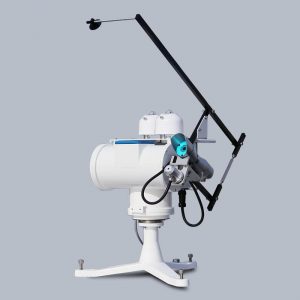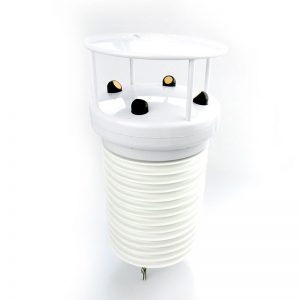The system is based on the STR-21G Sun tracker with a new shading disk assembly which can be mounted on one arm of the tracker. In combination with the new generation MS-80 Secondary standard pyranometer and MS-57 First class pyrheliometer, the STR-21G-S2 is the most “high end” sensor system for solar energy research.
The STR-21G-S2 system can be freely configured to measure the required Solar radiation components in the most accurate way. Hence, a cost-effective solution can be created for every application. In harsh climate environments, the MV-01 ventilator & heater can be deployed. The MS-57 pyrheliometer has a heated front window to avoid condensation and ice which can affect the measurements.
Global radiation can be composed by the sum of the cosine weighted direct and diffuse. This way the sun tracker with pyrheliometer and shaded pyranometer can provide all three Solar radiation components. The addition of the MS-80 for GHI measurements, data can be verified by comparing the measured values to the calculated GHI. Unique to the system, EKO’s radiometers have the ability to sample much faster than traditional solar sensors. Faster sample rates allow the sensor to ‘catch’ more accurately the peak irradiance value under variable atmospheric conditions and lower the measurement uncertainty of one-minute average values.
Applications and uses
Photovoltaic energy production
Solar radiation is not only the driving force behind the Earth’s weather phenomena, it also drives photovoltaic energy production. One day of solar energy received by the Earth exceeds the amount of worldwide energy consumption per year. Exploring this merely inexhaustible source of energy – either by direct transformation of radiant energy into electricity or by indirect energy production via wind, waves, etc. – seems to be the obvious way to go. In this context solar radiation measurements are of primary interest for applications like site-specific solar resource assessments, PV performance evaluation, solar resource forecasting, and so on. However, as with most real-world measurement systems, the difficulties are in the details. Reliable and accurate radiation measurements need some knowledge and attention: think of environmental influences (wind, rain/snow, soling), re-calibration (bi-annually), not to mention data processing, spectral effects, etc. The remaining part of this article intends to give you some background information and best-practice recommendations.
Basically, accurate and precise solar radiation measurements are obtained using two components: a suitable pyranometer and an adequate data logger. In some cases, mostly for dedicated scientific research, reference cell can be used in parallel to pyranometers. But reference cells are also widely used to measure solar radiation as if it were broad band radiometers. For such a use, however, there remains an issue with the spectral selectivity of reference cells. A pyranometer having a flat broad-band spectral response measures the incoming solar radiation homogeneously but reference cells are confined to their band-gab specific sensitivity so that reference cells will not measure solar radiation equally and homogeneously like pyranometers.
As mentioned above, radiation sensors are physical instruments which provide accurate measurements if some basic recommendations are followed. Every user of radiation sensors needs a reasonable awareness of their measurement quality. By taking into account some simple rules the data product generated by the radiometer will fulfill its need for your application more than enough.
DNI measurements with a pyrheliometer
Solar Direct Normal Irradiance (DNI) represents the direct solar component and contains about 80% of the total solar energy budget on earth. Outside the atmosphere (AM0) the solar irradiance is considdered as a constant (1367 W/m2) that slightly fluctuates with a 11 year cycle. The DNI at the earth surface is highly variable due to the atmospheric conditions (clouds, aerosols, water vapor and molecules).












